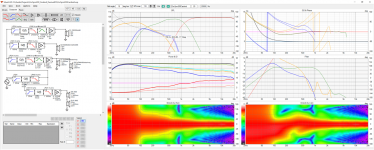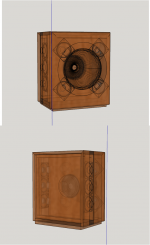Thanks for posting that!. It took me a few seconds too recognize what I was looking at because of the darkness of the horn picture and I was using my phone. That isn't a synergy, it breaks all the rules. The woofers are as far from the throat as possible instead of as close.
Its a waveguide with woofers around its rim - exactly what I've been simulating towards the end of this thread
misnamed line array....look back from end for relative content
If you put the woofers out at the mouth of the horn you don't get 1/4 summation like a synergy but the results are substantially the same across a listening window at a distance. You can do the trigonometry for the change in distance from CD diaphragm to LP vs woofer cone to LP when the LP is moved from on axis at say 3m to some distance off axis and see you can move quite far before it results in 90 degrees of phase change at woofer XO.
I simulated a lot of these with promising results but never built one. I was concerned about how much of the woofer energy would go back down the throat and return to create a null. From these results I would say not much. That is really helpful to know.
Its a waveguide with woofers around its rim - exactly what I've been simulating towards the end of this thread
misnamed line array....look back from end for relative content
If you put the woofers out at the mouth of the horn you don't get 1/4 summation like a synergy but the results are substantially the same across a listening window at a distance. You can do the trigonometry for the change in distance from CD diaphragm to LP vs woofer cone to LP when the LP is moved from on axis at say 3m to some distance off axis and see you can move quite far before it results in 90 degrees of phase change at woofer XO.
I simulated a lot of these with promising results but never built one. I was concerned about how much of the woofer energy would go back down the throat and return to create a null. From these results I would say not much. That is really helpful to know.
Its a waveguide with woofers around its rim
Perhaps you're right, it's more like an Genelec 83xx
Nice! I wonder what the price is - and I saw they are made in Latvia, so no import fees. There is also quite a lot of information useful for building one's own version.
Its easy enough to make your own if you are into 3D printing. Use ATH to make an axisymmetric waveguide that terminates in a baffle Surround the waveguide with 3" drivers on the back side of the baffle feeding through bandpass holes at the rim. Sound easy? It is now with this proof of concept. I confess not quite easy enough for me since I didn't do it. I was all set to go but got caught up in a non-audio project... I have a fairly complete design in Vituix and Sketchup if anyone wants to see it.
And as a reward for that project, I bought a pair of KEF R3s which are coax that I suspect even Patrick would be able to listen to.
This same concept - rim drivers - is what Genelec has done and what you get with a coax that uses a separate waveguide for the tweeter instead of using the woofer cone as the waveguide. The problem with all of these coaxes except the Genelec and the KEF UniQ is that the lack of termination at the waveguide edge or the rim of the woofer's frame destroys the high end response. I also saw evidence of reflection nulls for the coax drivers with separate waveguides.
I'm happy with the KEF purchase. My only regret is not having had time to roll my own solution with ATH and rim drivers. I think that has potential to be quite good. Perhaps some day I will get to it.
And as a reward for that project, I bought a pair of KEF R3s which are coax that I suspect even Patrick would be able to listen to.
This same concept - rim drivers - is what Genelec has done and what you get with a coax that uses a separate waveguide for the tweeter instead of using the woofer cone as the waveguide. The problem with all of these coaxes except the Genelec and the KEF UniQ is that the lack of termination at the waveguide edge or the rim of the woofer's frame destroys the high end response. I also saw evidence of reflection nulls for the coax drivers with separate waveguides.
I'm happy with the KEF purchase. My only regret is not having had time to roll my own solution with ATH and rim drivers. I think that has potential to be quite good. Perhaps some day I will get to it.
That looks very cool - sort of in the same theme as what Bushmeister and I did with our bookshelf point source horns. I wonder how this is better than say, a 12in coaxial?
Like this:
https://www.bcspeakers.com/en/products/coaxial/12-0/8/12fhx76
Like this:
https://www.bcspeakers.com/en/products/coaxial/12-0/8/12fhx76
IME it's not based on making numerous 'focused' 2-way horn/woofer 'coax' speakers for early large hi-end Sony front projector HT/presentation systems and still 'kicking' myself for not seeing the 'forest for the trees' back in the 90's when Tom gave me some hints in a PM for his new patent.
well just look at how ugly the B&C data sheet FR is. See that sharp null at 1 Khz in the CD response and the general raggedness of the top end? and a less sharp and deep null further out in the woofer's response? That is why I turned away from pro coax drivers.That looks very cool - sort of in the same theme as what Bushmeister and I did with our bookshelf point source horns. I wonder how this is better than say, a 12in coaxial?
Like this:
https://www.bcspeakers.com/en/products/coaxial/12-0/8/12fhx76
I certainly am. Cheers.I have a fairly complete design in Vituix and Sketchup if anyone wants to see it.
Vituix and sketchup screenshots are attached. The Vituix shows a near ideal response. The first row of the schematic shows the DSP equalized response of a 200mm diameter ATH generated 1" exit waveguide crossed over at 1200 Hz. I would use BMS4550 with this.I certainly am. Cheers.
The next row of the waveguide is an array of 4 DMA80 3" drivers that play through bandpass holes at diagonal corner edges of the waveguide. You can see this in the xray view.
The next row is the two side arrays. Each side array is 3 DM80s playing through bandpass holes disguised by the black vertical stripes on the cabinet. You can see in the xray back view that a vertical partition separates the top cabinet into front and rear volumes.
The next row is global equalization. I first dial in a textbook LR4 XO between CD and rim drivers. I next add the side arrays with the same equalization as the rim drivers but delayed and inverted for cardioid. To shape/optimize the cardioid response there is one PEQ in this chain. It is high passed at 100 Hz so side and rear rejection extend down to there.
Finally, on the bottom row is a stack of 2 UM8-22 8" subwoofers which provide enough bass for full range music up to 105 db peak SPL. The waveguide has a trim ring to hide/disguise the bandpass holes. The UM8 has a matching trim ring to match.
Attachments
That was very interesting, thank you. I'm about to do a couple of new designs and your project has given me a some ideas to potentially explore once I get set up again post move. I'll have a much bigger testing area then too, which is better than the current apartment verandah.
I'm downsized to a townhouse myself which is one of the reasons I've not moved forward on this. It always takes longer than you think to get back into DIY after a move
I'm going the other way, apartment to (small) house, city to country.I'm downsized to a townhouse myself which is one of the reasons I've not moved forward on this.
Tell me about it. Most of the parts haven't been packed well in that they're not sorted the best, but I have a partner who's hassling me to get up and running ASAP as we have some industrial projects to complete before we can get to the new CNC and speakers. The notebook in front of me is full of sketches for potential projects.It always takes longer than you think to get back into DIY after a move
I have made some really cardioid experiments and tried some small drivers above and below a rectangular WG for some directivity that I want to expand on that later in the year, plus some more MEH designs.
- Home
- Loudspeakers
- Multi-Way
- Two Way Synergy???


